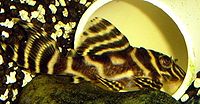L333 (Hypancistrus sp "L333")
From The Aquarium Wiki
(Redirected from L333)
Hypancistrus sp "L333"
57 Litres (15 US G.)
14.7-15.2cm (5.8-6 ")
Freshwater
6.2 - 7.2
26 -31 °C (78.8-87.8°F)
4-10 °d
1:1 M:F
5-8 years
Family
Loricariidae
Contents
Additional names
Sexing[edit]
- Hair like odontodes on males grow very visible compared to females. These odontodes appear on the pectoral fins.
- Another sexing method is to observe head shape. Males tend to be short headed but very broad. Females are elongated in the face and seem to be quite heavy set in the pectoral/chest area. There is recordings of males being the only one to enter caves but this is not always the case.
- This species can take up to two years if not more to mature. Sexing is extremely difficult until then.
Tank compatibility[edit]
- Best not to mix with strict herbivorous species due to the amount of protein these fish need. Can be territorial to other bottom dwellers. Make sure to supply enough caves for every male and hiding places for females.
- L333 do not mix well with fast or vigorous species as they tend to fright quite easily resulting in injury.
- Slow moving small to medium sized fish including Tetras, Rasboras, Gouramis and Killifish species are best tank mates generally residing in the mid to surface space of the aquarium.
Diet[edit]
- Prefers meaty products such as Mussels, Shrimp, Bloodworms, Beef Heart, Prawn etc but does accept quite a variety of manufactured foods and vegetable matter such as zucchini, squash and potato. This fish is not an algae eater.
Feeding regime[edit]
- Best to feed around sunset or during the dark as these fish are nocturnal.
Environment specifics[edit]
- Usually found in fast moving waters in the lower Xingu containing a fare amount of tannin and bog wood. Provide this fish with a good current and well filtered spacious tank with plenty of hiding places. Will not appreciate bright lights, dim lighting will mean this fish is more likely to be seen during the day.
Behaviour[edit]
- This species of Hypancistrus are typically quite acceptant of there own kind providing enough caves for males is a must as males will fight for caves within certain territory.
Identification[edit]
- Identification of this species is quite difficult as there are many colour variants. Is generally found to be yellow in base colour with many irregular dark brown bands or stripes vertically down the body and through the fins. Can be mistaken for L066.
